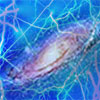The Electric Universe – A New Paradigm
 by Wal Thornhill
by Wal Thornhill
Introduction
In the wake of recent discoveries, a new way of seeing the physical universe is emerging. The new vantage point emphasizes the role of electricity in space and shows the negligible contribution of gravity in cosmic events.
Images returned by high-powered telescopes and recent space probes have challenged astronomers’ long-standing assumptions about galaxies and their constituent stars, about the evolution of our solar system, and about the nature and history of Earth.
The new discoveries also suggest that our early ancestors may have witnessed awe inspiring electrical events in the heavens—the source of myths and symbols around the world.
Today, magnetic fields are detected everywhere, even in the “empty” depths of intergalactic space. Magnetic fields cannot exist without causative electric currents. The naked electric force is 39 orders of magnitude (a thousand billion billion billion billion times) stronger than gravity. The visible universe is constituted almost entirely of electrically active plasma.
In the twentieth-century, the pioneers of plasma science inspired a new school of investigation called plasma cosmology. Plasma cosmologists suggest that electricity is the primary force organizing spiral galaxies and the astonishing galactic clusters now seen in deep space.
Plasma cosmology has achieved surprising success in predicting major discoveries of the space age. This new perspective does not require purely theoretical inventions based on mathematical assumptions like the Big Bang, dark matter, dark energy, neutron stars, or Black Holes.
Stars
An Electric Universe extends the findings of plasma cosmology to the formation and evolution of stars and their planetary satellites. Stars are formed at the intersections of galactic current filaments in dusty space plasma. The size of a star and its color are determined electrically and may change suddenly. Novae and supernovae are the explosive response of stars to a power surge in their galactic circuit.
Proponents of the Electric Universe suggest that there are no isolated islands in the universe. All objects in space, from subatomic particles to galactic clusters, are connected by manifestations of the electric force acting in real-time.
The Standard Model of the Sun proposes that pressure at the core of the Sun provokes a thermonuclear reaction. Proponents of this model say that this thermonuclear furnace causes the Sun to shine.
The Electric Sun Model, on the other hand, envisions thermonuclear reactions and neutrino production at or close to the surface of the Sun where the maximum exchange between the Sun and its external environment occurs.
It is electricity that energizes the stars, including the Sun, in a form of glow discharge. This external power source explains why the temperature of the Sun increases above the photosphere to coronal temperatures of 2 million degrees. Powerful plasma feedback effects maintain a steady output of visible solar radiation while variations in power input show up in the familiar sunspot cycle.
It is in the nature of a glow discharge that all stars possess a weak electric field beyond the corona. As charged particles of the solar wind move away from the Sun, they continue to be accelerated due to the Sun’s electric field, which extends to the heliopause.
Comets
Comets are electrically charged bodies moving on elliptical orbits through the Sun’s interplanetary electric field. As it approaches the Sun, the comet’s swift radial movement develops arcing on the nucleus. The arcs produce jets of dust and ions that form the coma and visible tails.
Many comets are solid rocks with dry surfaces. The sharply defined features of comet nuclei make clear that they are not “dirty snowballs” sublimating in the Sun. Due to the electric force, a comet can entrain a mass of hydrogen from the Sun greater than the mass of the comet’s nucleus. The unexpected X-rays of a cometary discharge can reach 2 million degrees.
Cometary nuclei reveal deeply cratered and blackened surfaces due to electric arcing. Since comet nuclei are eroded electrically, they could not survive across eons of solar system history and may have been produced much more recently than proposed in the Standard Model.
Planetary Science
In the recent history of the solar system, its electrical environment changed. Under changing electrical conditions planetary orbits changed as well. Close approaches of planets led to powerful electric arcing between planets and moons. All rocky bodies in the solar system show the massive scars of these kinds of electrical events.
Electric discharge scarring is occurring even now on Jupiter’s closest moon, Io, and on Saturn’s moon, Enceladus. Electrical activity continues on Mars, driving “dust devils” the size of Mount Everest – created by the electrical differential between the surface of Mars and surrounding space.
All of the dominant surface features of Mars show the patterns of electric discharge, suggesting that in the past a vast quantity of material was excavated electrically from Mars. Electric Universe proponents suggest that it was an interplanetary arc that created the Martian Valles Marineris, the largest known scar on a solid planet. Much of the rocky material exploding from Mars became comets, asteroids, and meteorites.
For more information on the Electric Universe scientific paradigm:
Welcome to the Electric Universe! video
Essential Guide to the Electric Universe
Posted in Science For The New Agewith comments disabled.





